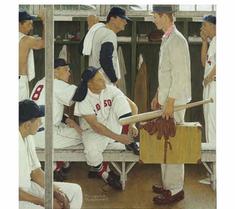Norman Rockwell
 When Norman Rockwell was 9, his genteel middle-income family moved to Mamaroneck, New York. His grandfather was Howard Hill, an unsuccessful English artist. As a high school freshman, he studied at the Chase School of Art. The next year he left high school for the National Academy of Art, earning his way through odd jobs that included designing cards for Arnold Constable and teaching painting to Ethel Barrymore—”me, a long, gawky kind bending over graceful Ethel Barrymore, guiding her shapely hand across the paper…my great Adam’s apple churning up and down my neck.” At 16, he transferred to the Art Students League to learn to “paint storytelling pictures.” He was the pupil of Bridgman for life class and of Fogarty for illustration. At 17, he was illustrating books, and at 18 was art director for Boys Life. When his parents moved to New Rochelle, New York, he shared a studio there with the established illustrator Clyde Forsyth. At 22, he sold his first five covers to George Horace Lorimer of The Saturday Evening Post—the beginning of 318 such covers in a career that made Rockwell the most popular living American artist.
When Norman Rockwell was 9, his genteel middle-income family moved to Mamaroneck, New York. His grandfather was Howard Hill, an unsuccessful English artist. As a high school freshman, he studied at the Chase School of Art. The next year he left high school for the National Academy of Art, earning his way through odd jobs that included designing cards for Arnold Constable and teaching painting to Ethel Barrymore—”me, a long, gawky kind bending over graceful Ethel Barrymore, guiding her shapely hand across the paper…my great Adam’s apple churning up and down my neck.” At 16, he transferred to the Art Students League to learn to “paint storytelling pictures.” He was the pupil of Bridgman for life class and of Fogarty for illustration. At 17, he was illustrating books, and at 18 was art director for Boys Life. When his parents moved to New Rochelle, New York, he shared a studio there with the established illustrator Clyde Forsyth. At 22, he sold his first five covers to George Horace Lorimer of The Saturday Evening Post—the beginning of 318 such covers in a career that made Rockwell the most popular living American artist.
His procedure was to pencil a loose 2 x 3″ sketch on a scrap of paper. Second, make individual drawings or (after 1937) photographs of each element of the painting, using the models and props he gathered, on the spot or in a simulated background. Third, do a full-size charcoal drawing. Fourth, make color sketches for the final painting—or, project a photograph onto a white canvas, draw with charcoal, and paint. Rockwell is not a Western artist and had not been West when he painted his 8/13/27 cover of the “old-timey” cowboy with his nostalgic gear. The 4/23/38 cover was a bedraggled Indian. The 9/25/54 cover showed the rancher’s son off to college. In 1966, Rockwell did a promotional series for the movie “Stagecoach.” In 1969, Rockwell went to Arizona for a painting of Glen Canyon Dam that included the neighboring Navajos. His portrait of the actor John Wayne hangs in the Cowboy Hall of Fame.
Resource: SAMUELS’ Encyclopedia of ARTISTS of THE AMERICAN WEST,
Peggy and Harold Samuels, 1985, Castle Publishing